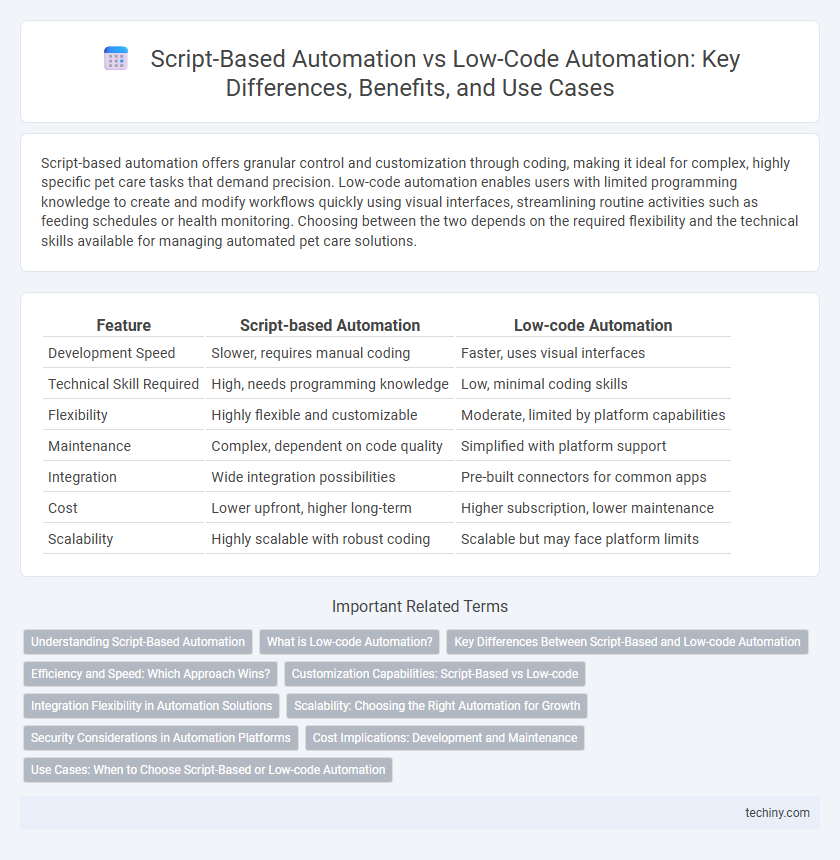Script-based automation offers granular control and customization through coding, making it ideal for complex, highly specific pet care tasks that demand precision. Low-code automation enables users with limited programming knowledge to create and modify workflows quickly using visual interfaces, streamlining routine activities such as feeding schedules or health monitoring. Choosing between the two depends on the required flexibility and the technical skills available for managing automated pet care solutions.
Table of Comparison
| Feature | Script-based Automation | Low-code Automation |
|---|---|---|
| Development Speed | Slower, requires manual coding | Faster, uses visual interfaces |
| Technical Skill Required | High, needs programming knowledge | Low, minimal coding skills |
| Flexibility | Highly flexible and customizable | Moderate, limited by platform capabilities |
| Maintenance | Complex, dependent on code quality | Simplified with platform support |
| Integration | Wide integration possibilities | Pre-built connectors for common apps |
| Cost | Lower upfront, higher long-term | Higher subscription, lower maintenance |
| Scalability | Highly scalable with robust coding | Scalable but may face platform limits |
Understanding Script-Based Automation
Script-based automation leverages programming languages such as Python, JavaScript, or Shell to create highly customizable workflows tailored to specific tasks and environments. This approach demands strong coding skills but offers granular control over automation processes, enabling intricate logic and integrations that low-code platforms may not support. Enterprises prioritize script-based automation for complex, unique requirements where flexibility and precision are critical to operational efficiency.
What is Low-code Automation?
Low-code automation enables users to design, build, and deploy automated workflows through visual interfaces with minimal hand-coding, accelerating development cycles and reducing dependency on traditional programming skills. It leverages drag-and-drop tools, pre-built templates, and reusable components to streamline complex business processes, making automation accessible to non-technical users and IT teams alike. This approach enhances scalability and adaptability, allowing organizations to rapidly respond to evolving operational demands.
Key Differences Between Script-Based and Low-code Automation
Script-based automation relies on manual coding using programming languages like Python or JavaScript to create highly customizable and complex workflows, demanding advanced technical skills from developers. Low-code automation utilizes visual interfaces and drag-and-drop tools to design workflows with minimal coding, enabling faster deployment and easier maintenance by non-developers or business users. Key differences include the level of technical expertise required, speed of implementation, scalability, and flexibility, with script-based offering greater customization and low-code prioritizing accessibility and rapid development.
Efficiency and Speed: Which Approach Wins?
Script-based automation offers granular control and customization, making it ideal for complex workflows but often requires specialized coding skills and longer development times. Low-code automation accelerates deployment with visual interfaces and pre-built components, significantly improving efficiency and speed for routine tasks by minimizing manual coding. Enterprises prioritizing rapid scalability and user accessibility typically benefit more from low-code platforms, while script-based solutions suit scenarios demanding highly tailored automation.
Customization Capabilities: Script-Based vs Low-code
Script-based automation offers extensive customization capabilities by allowing users to write detailed, precise code tailored to specific workflows and complex logic. Low-code automation provides a user-friendly interface with pre-built components that enable faster deployment but may limit deep customization for highly specialized tasks. Organizations seeking granular control and adaptability typically prefer script-based solutions, while those prioritizing speed and ease of use often choose low-code platforms.
Integration Flexibility in Automation Solutions
Script-based automation offers unparalleled integration flexibility by enabling developers to write custom code that connects disparate systems and APIs, accommodating complex workflows and unique business requirements. Low-code automation platforms streamline integration through pre-built connectors and drag-and-drop interfaces, accelerating deployment while limiting customization options for specialized or legacy systems. Organizations prioritizing highly tailored automation favor script-based solutions, whereas those seeking rapid implementation with moderate integration needs often opt for low-code platforms.
Scalability: Choosing the Right Automation for Growth
Script-based automation offers high scalability through customizable scripts that can handle complex, large-scale processes, making it ideal for enterprises with specific and evolving needs. Low-code automation enables rapid deployment and easier scaling by utilizing visual interfaces and prebuilt components, which suits growing businesses seeking efficient expansion with minimal coding expertise. Selecting the right approach depends on balancing the need for deep customization against the speed and flexibility required for sustainable growth.
Security Considerations in Automation Platforms
Script-based automation offers granular control over security configurations allowing developers to implement custom security protocols but requires advanced coding expertise to avoid vulnerabilities. Low-code automation platforms provide built-in security features such as role-based access control and automated compliance checks, reducing the risk of human error and accelerating secure deployment. Evaluating factors like integration capabilities with existing security frameworks and real-time threat monitoring is essential to choosing the right automation approach.
Cost Implications: Development and Maintenance
Script-based automation often requires specialized programming skills, leading to higher initial development costs and longer project timelines. Low-code automation platforms reduce expenses by enabling non-developers to create and modify workflows with minimal technical expertise, lowering both development and maintenance costs. Over time, low-code solutions also minimize the need for continuous debugging and script updates, further decreasing overall operational expenses.
Use Cases: When to Choose Script-Based or Low-code Automation
Script-based automation excels in complex, highly customizable tasks requiring precise control, such as IT infrastructure management, software testing, and data processing workflows. Low-code automation suits users seeking rapid deployment and ease of use, ideal for business process automation, customer service workflows, and routine administrative tasks. Choosing between them depends on factors like technical expertise, scalability needs, and the complexity of the automation scenario.
Script-based Automation vs Low-code Automation Infographic

 techiny.com
techiny.com